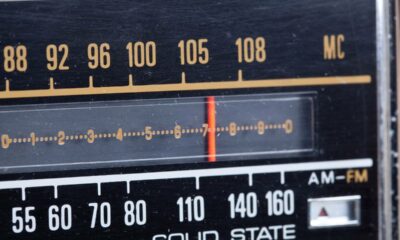Kaiser Health News
Watch and Listen: Opioid Settlement Case Triggers Protests Outside the High Court
Aneri Pattani
Tue, 05 Dec 2023 19:40:00 +0000
The Supreme Court heard a case this week about who could claim bankruptcy protection from civil lawsuits. The case stems from the opioid epidemic and lawsuits brought by state and local governments against the companies that made, sold, or distributed prescription painkillers — in this instance, Purdue Pharma, which marketed OxyContin.
The company filed for bankruptcy and agreed to pay settlements to governments, as well as individual victims of the opioid crisis. That bankruptcy provided Purdue Pharma liability protection from future civil cases about opioids. The family behind this company, the Sacklers, did not seek bankruptcy but requested the same liability protections.
Family members have offered to pay $6 billion from their personal fortune into the settlement, but only if they're given immunity. It's this stipulation that the Department of Justice opposes.
KFF Health News senior correspondent Aneri Pattani went to the site of the protests outside the Supreme Court building and talked to advocates and people affected by the opioid crisis to get their take on the case. She also was interviewed on WBUR's “Here & Now.”
——————————
By: Aneri Pattani
Title: Watch and Listen: Opioid Settlement Case Triggers Protests Outside the High Court
Sourced From: kffhealthnews.org/news/article/watch-and-listen-opioid-settlement-supreme-court-case-triggers-protests/
Published Date: Tue, 05 Dec 2023 19:40:00 +0000
Kaiser Health News
Tribal Nations Invest Opioid Settlement Funds in Traditional Healing to Treat Addiction
Aneri Pattani and Jazmin Orozco Rodriguez
Wed, 15 May 2024 09:00:00 +0000
PRESQUE ISLE, Maine — Outside the Mi'kmaq Nation's health department sits a dome-shaped tent, built by hand from saplings and covered in black canvas. It's one of several sweat lodges on the tribe's land, but this one is dedicated to helping people recover from addiction.
Up to 10 people enter the lodge at once. Fire-heated stones — called grandmothers and grandfathers, for the spirits they represent — are brought inside. Water is splashed on the stones, and the lodge fills with steam. It feels like a sauna, but hotter. The air is thicker, and it's dark. People pray and sing songs. When they leave the lodge, it is said, they reemerge from the mother's womb. Cleansed. Reborn.
The experience can be “a vital tool” in healing, said Katie Espling, health director for the roughly 2,000-member tribe.
She said patients in recovery have requested sweat lodges for years as a cultural element to complement the counseling and medications the tribe's health department already provides. But insurance doesn't cover sweat ceremonies, so, until now, the department couldn't afford to provide them.
In the past year, the Mi'kmaq Nation received more than $150,000 from settlements with companies that made or sold prescription painkillers and were accused of exacerbating the overdose crisis. A third of that money was spent on the sweat lodge.
Health care companies are paying out more than $1.5 billion to hundreds of tribes over 15 years. This windfall is similar to settlements that many of the same companies are paying to state governments, which total about $50 billion.
To some people, the lower payout for tribes corresponds to their smaller population. But some tribal citizens point out that the overdose crisis has had a disproportionate effect on their communities. Native Americans had the highest overdose death rates of any racial group each year from 2020 to 2022. And federal officials say those statistics were likely undercounted by about 34% because Native Americans' race is often misclassified on death certificates.
Still, many tribal leaders are grateful for the settlements and the unique way the money can be spent: Unlike the state payments, money sent to tribes can be used for traditional and cultural healing practices — anything from sweat lodges and smudging ceremonies to basketmaking and programs that teach tribal languages.
“To have these dollars to do that, it's really been a gift,” said Espling of the Mi'kmaq tribe. “This is going to absolutely be fundamental to our patients' well-being” because connecting with their culture is “where they'll really find the deepest healing.”
Public health experts say the underlying cause of addiction in many tribal communities is intergenerational trauma, resulting from centuries of brutal treatment, including broken treaties, land theft, and a government-funded boarding school system that sought to erase the tribes' languages and cultures. Along with a long-running lack of investment in the Indian Health Service, these factors have led to lower life expectancy and higher rates of addiction, suicide, and chronic diseases.
Using settlement money to connect tribal citizens with their traditions and reinvigorate pride in their culture can be a powerful healing tool, said Andrea Medley, a researcher with the Johns Hopkins Center for Indigenous Health and a member of the Haida Nation. She helped create principles for how tribes can consider spending settlement money.
Medley said that having respect for those traditional elements outlined explicitly in the settlements is “really groundbreaking.”
‘A Drop in the Bucket'
Of the 574 federally recognized tribes, more than 300 have received payments so far, totaling more than $371 million, according to Kevin Washburn, one of three court-appointed directors overseeing the tribal settlements.
Although that sounds like a large sum, it pales in comparison with what the addiction crisis has cost tribes. There are also hundreds of tribes that are excluded from the payments because they aren't federally recognized.
“These abatement funds are like a drop in the bucket compared to what they've spent, compared to what they anticipate spending,” said Corey Hinton, a lawyer who represented several tribes in the opioid litigation and a citizen of the Passamaquoddy Tribe. “Abatement is a cheap term when we're talking about a crisis that is still engulfing and devastating communities.”
Even leaders of the Navajo Nation — the largest federally recognized tribe in the United States, which has received $63 million so far — said the settlements can't match the magnitude of the crisis.
“It'll do a little dent, but it will only go so far,” said Kim Russell, executive director of the Navajo Department of Health.
The Navajo Nation is trying to stretch the money by using it to improve its overall health system. Officials plan to use the payouts to hire more coding and billing employees for tribe-operated hospitals and clinics. Those workers would help ensure reimbursements keep flowing to the health systems and would help sustain and expand services, including addiction treatment and prevention, Russell said.
Navajo leaders also want to hire more clinicians specializing in substance use treatment, as well as primary care doctors, nurses, and epidemiologists.
“Building buildings is not what we want” from the opioid settlement funds, Russell said. “We're nation-building.”
High Stakes for Small Tribes
Smaller nations like the Poarch Band of Creek Indians in southern Alabama are also strategizing to make settlement money go further.
For the tribe of roughly 2,900 members, that has meant investing $500,000 — most of what it has received so far — into a statistical modeling platform that its creators say will simulate the opioid crisis, predict which programs will save the most lives, and help local officials decide the most effective use of future settlement cash.
Some recovery advocates have questioned the model's value, but the tribe's vice chairman, Robert McGhee, said it would provide the data and evidence needed to choose among efforts competing for resources, such as recovery housing or peer support specialists. The tribe wants to do both, but realistically, it will have to prioritize.
“If we can have this model and we put the necessary funds to it and have the support, it'll work for us,” McGhee said. “I just feel it in my gut.”
The stakes are high. In smaller communities, each death affects the whole tribe, McGhee said. The loss of one leader marks decades of lost knowledge. The passing of a speaker means further erosion of the Native language.
For Keesha Frye, who oversees the Poarch Band of Creek Indians' tribal court and the sober living facility, using settlement money effectively is personal. “It means a lot to me to get this community well because this is where I live and this is where my family lives,” she said.
Erik Lamoreau in Maine also brings personal ties to this work. More than a decade ago, he sold drugs on Mi'kmaq lands to support his own addiction.
“I did harm in this community and it was really important for me to come back and try to right some of those wrongs,” Lamoreau said.
Today, he works for the tribe as a peer recovery coordinator, a new role created with the opioid settlement funds. He uses his experience to connect with others and help them with recovery — whether that means giving someone a ride to court, working on their résumé, exercising together at the gym, or hosting a cribbage club, where people play the card game and socialize without alcohol or drugs.
Beginning this month, Lamoreau's work will also involve connecting clients who seek cultural elements of recovery to the new sweat lodge service — an effort he finds promising.
“The more in tune you are with your culture — no matter what culture that is — it connects you to something bigger,” Lamoreau said. “And that's really what we look at when we're in recovery, when we talk about spiritual connection. It's something bigger than you.”
——————————
By: Aneri Pattani and Jazmin Orozco Rodriguez
Title: Tribal Nations Invest Opioid Settlement Funds in Traditional Healing to Treat Addiction
Sourced From: kffhealthnews.org/news/article/tribal-nations-opioid-settlement-funds-cultural-traditional-healing/
Published Date: Wed, 15 May 2024 09:00:00 +0000
Did you miss our previous article…
https://www.biloxinewsevents.com/after-a-childs-death-california-weighs-rules-for-phys-ed-during-extreme-weather/
Kaiser Health News
After a Child’s Death, California Weighs Rules for Phys Ed During Extreme Weather
Samantha Young
Wed, 15 May 2024 09:00:00 +0000
LAKE ELSINORE, Calif. — Yahushua Robinson was an energetic boy who jumped and danced his way through life. Then, a physical education teacher instructed the 12-year-old to run outside on a day when the temperature climbed to 107 degrees.
“We lose loved ones all the time, but he was taken in a horrific way,” his mother, Janee Robinson, said from the family's Inland Empire home, about 80 miles southeast of Los Angeles. “I would never want nobody to go through what I'm going through.”
The day her son died, Robinson, who teaches phys ed, kept her elementary school students inside, and she had hoped her children's teachers would do the same.
The Riverside County Coroner's Bureau ruled that Yahushua died on Aug. 29 of a heart defect, with heat and physical exertion as contributing factors. His death at Canyon Lake Middle School came on the second day of an excessive heat warning, when people were advised to avoid strenuous activities and limit their time outdoors.
Yahushua's family is supporting a bill in California that would require the state Department of Education to create guidelines that govern physical activity at public schools during extreme weather, including setting threshold temperatures for when it's too hot or too cold for students to exercise or play sports outside. If the measure becomes law, the guidelines will have to be in place by Jan. 1, 2026.
Many states have adopted protocols to protect student athletes from extreme heat during practices. But the California bill is broader and would require educators to consider all students throughout the school day and in any extreme weather, whether they're doing jumping jacks in fourth period or playing tag during recess. It's unclear if the bill will clear a critical committee vote scheduled for May 16.
“Yahushua's story, it's very touching. It's very moving. I think it could have been prevented had we had the right safeguards in place,” said state Sen. Melissa Hurtado (D-Bakersfield), one of the bill's authors. “Climate change is impacting everyone, but it's especially impacting vulnerable communities, especially our children.”
Last year marked the planet's warmest on record, and extreme weather is becoming more frequent and severe, according to the National Oceanic and Atmospheric Administration. Even though most heat deaths and illnesses are preventable, about 1,220 people in the United States are killed by extreme heat every year, according to the Centers for Disease Control and Prevention.
Young children are especially susceptible to heat illness because their bodies have more trouble regulating temperature, and they rely on adults to protect them from overheating. A person can go from feeling dizzy or experiencing a headache to passing out, having a seizure, or going into a coma, said Chad Vercio, a physician and the division chief of general pediatrics at Loma Linda University Health.
“It can be a really dangerous thing,” Vercio said of heat illness. “It is something that we should take seriously and figure out what we can do to avoid that.”
It's unclear how many children have died at school from heat exposure. Eric Robinson, 15, had been sitting in his sports medicine class learning about heatstroke when his sister arrived at his high school unexpectedly the day their brother died.
“They said, ‘OK, go home, Eric. Go home early.' I walked to the car and my sister's crying. I couldn't believe it,” he said. “I can't believe that my little brother's gone. That I won't be able to see him again. And he'd always bugged me, and I would say, ‘Leave me alone.'”
That morning, Eric had done Yahushua's hair and loaned him his hat and chain necklace to wear to school.
As temperatures climbed into the 90s that morning, a physical education teacher instructed Yahushua to run on the blacktop. His friends told the family that the sixth grader had repeatedly asked the teacher for water but was denied, his parents said.
The school district has refused to release video footage to the family showing the moment Yahushua collapsed on the blacktop. He died later that day at the hospital.
Melissa Valdez, a Lake Elsinore Unified School District spokesperson, did not respond to calls seeking comment.
Schoolyards can reach dangerously high temperatures on hot days, with asphalt sizzling up to 145 degrees, according to findings by researchers at the UCLA Luskin Center for Innovation. Some school districts, such as San Diego Unified and Santa Ana Unified, have hot weather plans or guidelines that call for limiting physical activity and providing water to kids. But there are no statewide standards that K-12 schools must implement to protect students from heat illness.
Under the bill, the California Department of Education must set temperature thresholds requiring schools to modify students' physical activities during extreme weather, such as heat waves, wildfires, excessive rain, and flooding. Schools would also be required to come up with plans for alternative indoor activities, and staff must be trained to recognize and respond to weather-related distress.
California has had heat rules on the books for outdoor workers since 2005, but it was a latecomer to protecting student athletes, according to the Korey Stringer Institute at the University of Connecticut, which is named after a Minnesota Vikings football player who died from heatstroke in 2001. By comparison, Florida, where Gov. Ron DeSantis, a Republican, this spring signed a law preventing cities and counties from creating their own heat protections for outdoor workers, has the best protections for student athletes, according to the institute.
Douglas Casa, a professor of kinesiology and the chief executive officer of the institute, said state regulations can establish consistency about how to respond to heat distress and save lives.
“The problem is that each high school doesn't have a cardiologist and doesn't have a thermal physiologist and doesn't have a sickling expert,” Casa said of the medical specialties for heat illness.
In 2022, California released an Extreme Action Heat Plan that recommended state agencies “explore implementation of indoor and outdoor heat exposure rules for schools,” but neither the administration of Gov. Gavin Newsom, a Democrat, nor lawmakers have adopted standards.
Lawmakers last year failed to pass legislation that would have required schools to implement a heat plan and replace hot surfaces, such as cement and rubber, with lower-heat surfaces, such as grass and cool pavement. That bill, which drew opposition from school administrators, stalled in committee, in part over cost concerns.
Naj Alikhan, a spokesperson for the Association of California School Administrators, said the new bill takes a different approach and would not require structural and physical changes to schools. The association has not taken a position on the measure, and no other organization has registered opposition.
The Robinson family said children's lives ought to outweigh any costs that might come with preparing schools to deal with the growing threat of extreme weather. Yahushua‘s death, they say, could save others.
“I really miss him. I cry every day,” said Yahushua's father, Eric Robinson. “There's no one day that go by that I don't cry about my boy.”
This article was produced by KFF Health News, which publishes California Healthline, an editorially independent service of the California Health Care Foundation.
——————————
By: Samantha Young
Title: After a Child's Death, California Weighs Rules for Phys Ed During Extreme Weather
Sourced From: kffhealthnews.org/news/article/california-weighs-heat-climate-school-rules-physical-education-child-death/
Published Date: Wed, 15 May 2024 09:00:00 +0000
Did you miss our previous article…
https://www.biloxinewsevents.com/medicaid-unwinding-decried-as-biased-against-disabled-people/
Kaiser Health News
Medicaid ‘Unwinding’ Decried as Biased Against Disabled People
Daniel Chang
Tue, 14 May 2024 09:00:00 +0000
Jacqueline Saa has a genetic condition that leaves her unable to stand and walk on her own or hold a job. Every weekday for four years, Saa, 43, has relied on a home health aide to help her cook, bathe and dress, go to the doctor, pick up medications, and accomplish other daily tasks.
Share Your Story With Us
Have you or someone you know with disabilities unexpectedly lost Medicaid benefits since April 2023? Tell us about it here.
She received coverage through Florida's Medicaid program until it abruptly stopped at the end of March, she said.
“Every day the anxiety builds,” said Saa, who lost her home health aide for 11 days, starting April 1, despite being eligible. The state has since restored Saa's home health aide service, but during the gap she leaned on her mother and her 23- and 15-year-old daughters, while struggling to regain her Medicaid benefits.
“It's just so much to worry about,” she said. “This is a health care system that's supposed to help.”
Medicaid's home and community-based services are designed to help people like Saa, who have disabilities and need help with everyday activities, stay out of a nursing facility. But people are losing benefits with little or no notice, getting bad advice when they call for information, and facing major disruptions in care while they wait for the issue to get sorted out, according to attorneys and advocates who are hearing from patients.
In Colorado, Texas, and Washington, D.C., the National Health Law Program, a nonprofit that advocates for low-income and underserved people, has filed civil rights complaints with two federal agencies alleging discrimination against people with disabilities. The group has not filed a lawsuit in Florida, though its attorneys say they've heard of many of the same problems there.
Attorneys nationwide say the special needs of disabled people were not prioritized as states began to review eligibility for Medicaid enrollees after a pandemic-era mandate for coverage expired in March 2023.
“Instead of monitoring and ensuring that people with disabilities could make their way through the process, they sort of treated them like everyone else with Medicaid,” said Elizabeth Edwards, a senior attorney for the National Health Law Program. Federal law puts an “obligation on states to make sure people with disabilities don't get missed.”
At least 21 million people nationwide have been disenrolled from Medicaid since states began eligibility redeterminations in spring 2023, according to a KFF analysis.
The unwinding, as it's known, is an immense undertaking, Edwards said, and some states did not take extra steps to set up a special telephone line for those with disabilities, for example, so people could renew their coverage or contact a case manager.
As states prepared for the unwinding, the Centers for Medicare & Medicaid Services, the federal agency that regulates Medicaid, advised states that they must give people with disabilities the help they need to benefit from the program, including specialized communications for people who are deaf or blind.
The Florida Department of Children and Families, which verifies eligibility for the state's Medicaid program, has a specialized team that processes applications for home health services, said Mallory McManus, the department's communications director.
People with disabilities disenrolled from Medicaid services were “properly noticed and either did not respond timely or no longer met financial eligibility requirements,” McManus said, noting that people “would have been contacted by us up to 13 times via phone, mail, email, and text before processing their disenrollment.”
Allison Pellegrin of Ormond Beach, Florida, who lives with her sister Rhea Whitaker, who is blind and cognitively disabled, said that never happened for her family.
“They just cut off the benefits without a call, without a letter or anything stating that the benefits would be terminating,” Pellegrin said. Her sister's home health aide, whom she had used every day for nearly eight years, stopped service for 12 days. “If I'm getting everything else in the mail,” she said, “it seems weird that after 13 times I wouldn't have received one of them.”
Pellegrin, 58, a sales manager who gets health insurance through her employer, took time off from work to care for Whitaker, 56, who was disabled by a severe brain injury in 2006.
Medicaid reviews have been complicated, in part, by the fact that eligibility works differently for home health services than for general coverage, based on federal regulations that give states more flexibility to determine financial eligibility. Income limits for home health services are higher, for instance, and assets are counted differently.
In Texas, a parent in a household of three would be limited to earning no more than $344 a month to qualify for Medicaid. And most adults with a disability can qualify without a dependent child and be eligible for Medicaid home health services with an income of up to $2,800 a month.
The state was not taking that into consideration, said Terry Anstee, a supervising attorney for community integration at Disability Rights Texas, a nonprofit advocacy group.
Even a brief lapse in Medicaid home health services can fracture relationships that took years to build.
“It may be very difficult for that person who lost that attendant to find another attendant,” Anstee said, because of workforce shortages for attendants and nurses and high demand.
Nearly all states have a waiting list for home health services. About 700,000 people were on waiting lists in 2023, most of them with intellectual and developmental disabilities, according to KFF data.
Daniel Tsai, a deputy administrator at CMS, said the agency is committed to ensuring that people with disabilities receiving home health services “can renew their Medicaid coverage with as little red tape as possible.”
CMS finalized a rule this year for states to monitor Medicaid home health services. For example, CMS will now track how long it takes for people who need home health care to receive the services and will require states to track how long people are on waitlists.
Staff turnover and vacancies at local Medicaid agencies have contributed to backlogs, according to complaints filed with two federal agencies focused on civil rights.
The District of Columbia's Medicaid agency requires that case managers help people with disabilities complete renewals. However, a complaint says, case managers are the only ones who can help enrollees complete eligibility reviews and, sometimes, they don't do their jobs.
Advocates for Medicaid enrollees have also complained to the Federal Trade Commission about faulty eligibility systems developed by Deloitte, a global consulting firm that contracts with about two dozen states to design, implement, or operate automated benefits systems.
KFF Health News found that multiple audits of Colorado's eligibility system, managed by Deloitte, uncovered errors in notices sent to enrollees. A 2023 review by the Colorado Office of the State Auditor found that 90% of sampled notices contained problems, some of which violate the state's Medicaid rules. The audit blamed “flaws in system design” for populating notices with incorrect dates.
Deloitte declined to comment on specific state issues.
In March, Colorado officials paused disenrollment for people on Medicaid who received home health services, which includes people with disabilities, after a “system update” led to wrongful terminations in February.
Another common problem is people being told to reapply, which immediately cuts off their benefits, instead of appealing the cancellation, which would ensure their coverage while the claim is investigated, said attorney Miriam Harmatz, founder of the Florida Health Justice Project.
“What they're being advised to do is not appropriate. The best way to protect their legal rights,” Harmatz said, “is to file an appeal.”
But some disabled people are worried about having to repay the cost of their care.
Saa, who lives in Davie, Florida, received a letter shortly before her benefits were cut that said she “may be responsible to repay any benefits” if she lost her appeal.
The state should presume such people are still eligible and preserve their coverage, Harmatz said, because income and assets for most beneficiaries are not going to increase significantly and their conditions are not likely to improve.
The Florida Department of Children and Families would not say how many people with disabilities had lost Medicaid home health services.
But in Miami-Dade, Florida's most populous county, the Alliance for Aging, a nonprofit that helps older and disabled people apply for Medicaid, saw requests for help jump from 58 in March to 146 in April, said Lisa Mele, the organization's director of its Aging and Disability Resources Center.
“So many people are calling us,” she said.
States are not tracking the numbers, so “the impact is not clear,” Edwards said. “It's a really complicated struggle.”
Saa filed an appeal March 29 after learning from her social worker that her benefits would expire at the end of the month. She went to the agency but couldn't stand in a line that was 100 people deep. Calls to the state's Medicaid eligibility review agency were fruitless, she said.
“When they finally connected me to a customer service representative, she was literally just reading the same explanation letter that I've read,” Saa said. “I did everything in my power.”
Saa canceled her home health aide. She lives on limited Social Security disability income and said she could not afford to pay for the care.
On April 10, she received a letter from the state saying her Medicaid had been reinstated, but she later learned that her plan did not cover home health care.
The following day, Saa said, advocates put her in touch with a point person at Florida's Medicaid agency who restored her benefits. A home health aide showed up April 12. Saa said she's thankful but feels anxious about the future.
“The toughest part of that period is knowing that that can happen at any time,” she said, “and not because of anything I did wrong.”
Have you or someone you know with disabilities unexpectedly lost Medicaid benefits since April 2023? Tell KFF Health News about it here.
KFF Health News correspondents Samantha Liss and Rachana Pradhan contributed to this report.
——————————
By: Daniel Chang
Title: Medicaid ‘Unwinding' Decried as Biased Against Disabled People
Sourced From: kffhealthnews.org/news/article/medicaid-unwinding-people-with-disabilities-home-health-benefits/
Published Date: Tue, 14 May 2024 09:00:00 +0000
Did you miss our previous article…
https://www.biloxinewsevents.com/nursing-homes-wield-pandemic-immunity-laws-to-duck-wrongful-death-suits/
-
SuperTalk FM7 days ago
Mississippi governor approves bill allowing electronic search warrants
-
SuperTalk FM2 days ago
Martin Lawrence making 3 stops in Mississippi on comedy tour
-
Mississippi News6 days ago
Louisville names street after a former high school
-
SuperTalk FM7 days ago
$30 million RV park coming to Natchez features amphitheater, pickle ball courts, and more
-
Mississippi News7 days ago
Crews close Jackson street due to large sinkhole
-
Our Mississippi Home21 hours ago
Beat the Heat with Mississippi’s Best Waterparks
-
Mississippi News6 days ago
Man arrested for allegedly breaking into home, robbing owner
-
Mississippi Today5 days ago
Lawmakers may have to return to Capitol May 14 to override Gov. Tate Reeves’ potential vetoes









































